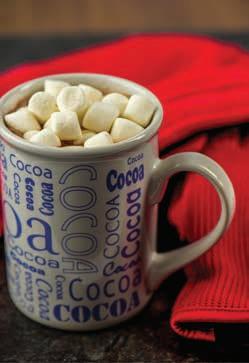6
Winter 2020
SEASONS® MAGAZINE
CONTENTS
06
How Chocolate Became Tied To Valentine’s Day
07
Countdown To Valentine’s Day
08
Tips to Protect Your Winter Wardrobe
10
Best Flu Hacks Every Traveler Should Know
12
Seasonal Recipe
14
Winter Events
16
St. Patrick's Day Recipe
18
How To Help The Homeless This Winter
20
Tips for a Stress-Free Tax Season
22
Shoppers’ guide to Presidents’ Day sales
How chocolate became tied to Valentine’s Day
H
eart-shaped boxes filled with decadent treats are coveted gifts on Valentine’s Day. Chocolate lovers typically have a favorite type of chocolate, whether it’s creamy filled truffles or chocolate pieces with fruit or nut fillings.
The tradition of gifting chocolate is anything but new. Chocolate and other sweet treats have been offered for centuries as prized gifts. Even ancient Aztecs and Mayans celebrated chocolate and saw it as a hot commodity. Drinks made of cacao beans would be given as presents to people of high status. Chocolate also would be offered to the gods as a token of appreciation. Cacao beans were even used as a form of currency at one point.
Publisher: Jeff Lambert Editor: Felicia Edwards Creative Director: Josh Marlowe Published By Long Island Media Group LLC For more information, or to advertise, call 631.226.2636 or visit www.theneighbornewspapers.com/seasons-magazine Copyright © 2020 by Long Island Media Group, LLC. All rights reserved. Reproduction in whole or in part without permission is prohibited. The publisher will not be responsible for errors in advertising beyond the cost of the space occupied by the error, and such responsibility, if any, shall be limited to the first use of advertising, in the case of repeated use. The publisher reserves the right to edit or reject any advertising at its sole discretion. The advertiser shall represent that all artwork and copy provided by the advertiser is owned by the advertiser, and it has the right to utilize such in this publication.
www.theneighbornewspapers.com/seasons-magazine
During the 17th century, chocolate consumption grew considerably across Europe. Chocolate houses cropped up in London, and the French elite often indulged in chocolate. Chocolate’s popularity continued to grow, but the dessert was not linked to Valentine’s Day until nearly 200 years later. In the mid-1800s, an enterprising individual named Richard Cadbury was looking for a way to make chocolate even more popular than it already was. He sought out a method to make drinking chocolate more palatable and created “eating chocolates.” These chocolates were packaged in decorative boxes. Eventually, Cadbury saw the benefit of putting images of cupids and roses on the boxes. Cadbury even designed chocolate boxes in the shape of hearts that could be saved as mementos. These chocolates soon became intertwined with Valentine’s Day celebrations.
EDITION SEVEN
On the other side of the Atlantic, Milton Hershey dabbled in commercializing chocolate as well. Hershey began as a caramel maker, but experimented with covering the caramels in chocolate in 1894. Hershey would go on to develop one of the most successful brands of chocolate in the United States, which included the famous Hershey bar. In 1907, Hershey launched production of tear-drop shaped “kisses.” (The chocolates were given their unusual name because of the “smooching” noise made by the chocolate when being manufactured.) The kisses became wildly popular and made for affordable chocolate gifts on Valentine’s Day.
Many other chocolate manufacturers soon began packaging their chocolates in special boxes for Valentine’s Day. Russell Stover and Whitmans are two such manufacturers who have long specialized in heart-shaped boxes or other decorative Valentine’s gifts.
Traditionally, men have gifted women with boxes of chocolate for Valentine’s Day. However, that role is reversed in other areas of the world. For example, in Japan, women give gifts — namely chocolates — to the men in their lives to express love, courtesy or social obligation. This tradition first began in 1936 when confectioner Morozoff Ltd. ran the first ever Valentine’s Day ad in Japan through a local English newspaper. By the 1950s, other Japanese confectioners were following suit. Whether one believes that chocolate symbolizes heightened status, acts as an aphrodisiac or is just a special treat, chocolates will likely always be associated with the day of love.
For More Information, Call 631.226.2636










